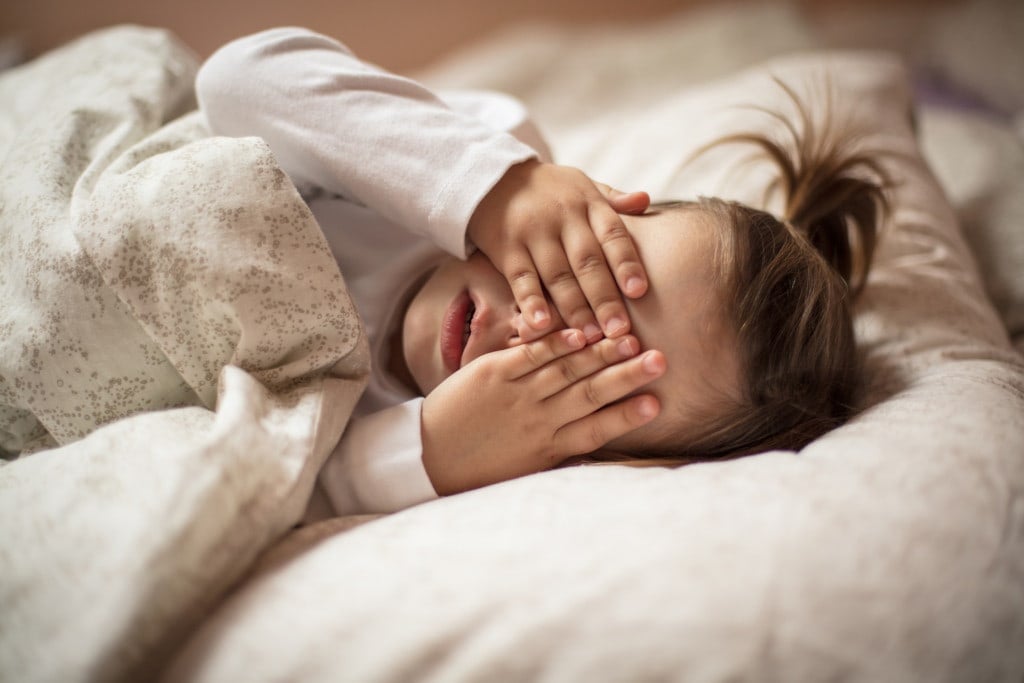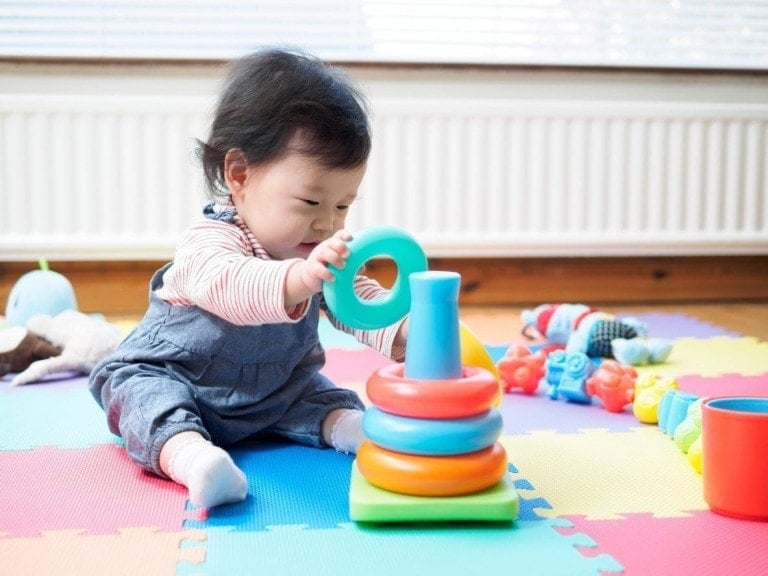With a good night’s sleep, children function well during the day and develop properly. Setting up good sleep patterns often requires having a routine in place. Children who go to bed late actually wake up prematurely, so getting children to bed earlier rather than later is best for getting a long sleep.
Toddlers ages 1-3 years old need anywhere from 11-14 hours of sleep over 24 hours. Without a healthy and consistent sleep cycle, toddlers can become overactive, moody, and highly irritable and may have trouble concentrating or focusing. Eventually, they can suffer from other long-term physical and mental health complications.
Toddlers also produce an important hormone called Growth Hormone (GH) during sleep. While adults produce this hormone throughout the day, it is only released in toddlers right after falling into a deep sleep. GH stimulates various biological events promoting healthy growth and development in your child’s muscles, organs, blood, and bones.1
If you’ve noticed your little one isn’t sleeping well or displays daytime symptoms of constant irritability or hyperactivity, read more on these abnormal sleep patterns to determine if one or more of these is occurring. Consult your child’s pediatrician or naturopath for guidance.
Abnormal Sleep Patterns in Toddlers
Bedtime Fears and Sleep Anxiety
If your toddler is regularly afraid of bedtime, he may be scared of the dark or associate his bed with feelings of anxiety. He may struggle with imagined triggers like “monsters under the bed.” Be compassionate about these larger-than-life fears. They feel very real to your little one. Think of ways to assure your toddler everything is okay. Provide practical assistance like a nightlight, soothing music, a picture of your family on his nightstand, or a lovey to settle him to sleep. It’s important that his bed not be a place of punishment or discipline. Otherwise, he’ll associate it that way, and it will prevent relaxation.
Insomnia
Is it a struggle for your child to fall asleep and stay asleep? Do they keep waking up during the night and then have difficulty getting back into a deep slumber? Insomnia is a common sleep disorder in children.2 It may be caused by mental health stress, too much screen time, caffeine, too much sugar, skin conditions like eczema, getting put to bed too late regularly, food and nutrient deficiencies, or other sleep disorders such as Restless Leg Syndrome or Sleep Apnea. Sometimes significant life changes such as moving or starting pre-school can induce stress-related insomnia. Consider making a soothing regimen (bath, story, music) a part of your toddler’s bedtime routine.
Restless Legs Syndrome (RLS)
Children with RLS tend to seek relief from their discomfort by moving their legs—such as fidgeting, stretching, walking, running, rocking, or changing positions in bed. In the United States alone, RLS is believed to affect approximately 1.5 million children. RLS is a neurological condition with a genetic component and often runs in families.3
Sleepwalking
Sleepwalking occurs when your child gets out of bed and is still asleep but exhibits some awareness and responsiveness to their surroundings.4 The risk is potential injury if your child collides with another object or loses their balance and falls. Sleepwalking is also a risk if your child opens doors and leaves the house without your knowledge. If sleepwalking for your toddler is a regular occurrence at night, consult your child’s pediatrician.
Bedwetting
Bedwetting is also called sleep enuresis and describes your child’s involuntary urination during sleep. It’s pretty common in young children.5 To be considered a sleep disorder, it must occur in people ages five and older and occur at least twice per week for at least three months. This isn’t a huge concern since your toddler is likely wearing a pull-up or still learning how to “hold it” during sleep times. However, if you feel you need some guidance from your pediatrician, reach out.
Teeth Grinding
Bruxism, or teeth grinding, is the involuntary clenching and grinding of teeth while your toddler sleeps. Sometimes their movements will resemble chewing but with more force. You’ll notice episodes of clenching and grinding. Your child may have a sore jaw or neck or wake up with a headache. In some instances, there may be damage to your little one’s teeth.
Snoring
If your child’s snoring is frequent and severe, it can impact their quality of sleep. Snoring may be caused by any of the following: anatomically large or swollen tonsils and adenoids, obesity, congestion, allergies, asthma, a deviated septum, or poor air quality.
Obstructive Sleep Apnea
Obstructive sleep apnea (OSA) results in constant lapses in your child’s breathing during the night. The lapses, or “apneas,” occur dozens of times throughout the night when your child’s airway gets blocked. It can have adverse side effects because it affects the amount of oxygen flowing to your child’s brain. OSA has been connected to impaired brain development, cardiovascular issues, mental health impacts, and altered metabolism. Luckily, there are solutions. If you suspect this might be occurring in your toddler, contact your child’s healthcare provider for guidance.
Nightmares
Nightmares in toddlers are scary, realistic dreams that your little one wakes up from crying, screaming, or in visible distress. These are dreams they can remember. Allowing them to talk it out and then soothing them with reassuring words, a gentle touch, or a glass of water can help calm them down and go back to sleep. These scary dreams typically occur during lighter REM (rapid eye movement) sleep, which happens more in the early morning hours. Try to put a light-hearted, happy spin on bedtime routines, even if it’s a simple change like choosing a cheerful bedtime book to read or singing a soothing song.
Night Terrors
Unlike nightmares, your child will not remember their night terrors. They aren’t associated with visual imagery in most instances. Night terrors are characterized by screaming or thrashing with their eyes wide open. It can be difficult for the parent because your toddler may not sense or recognize your presence as you try to comfort them. They happen during the first few hours of sleep—deep, non-REM sleep. Do not expose your children to scary movies or shows, as these will only fuel their fears at night.
Without a doubt, regularly getting a good night’s sleep is important. But it can be challenging for many toddlers and their parents. Especially if they suffer from one of these abnormal sleep patterns. So if you notice any of the above sleep patterns occurring regularly, try to respond to your toddler with compassion and reassurance. There are solutions for all of these abnormal sleep patterns. You are not alone! It might be time to seek the advice of a healthcare professional, naturopath, or sleep expert. They will help you and your child develop a plan with case-specific guidance.



































